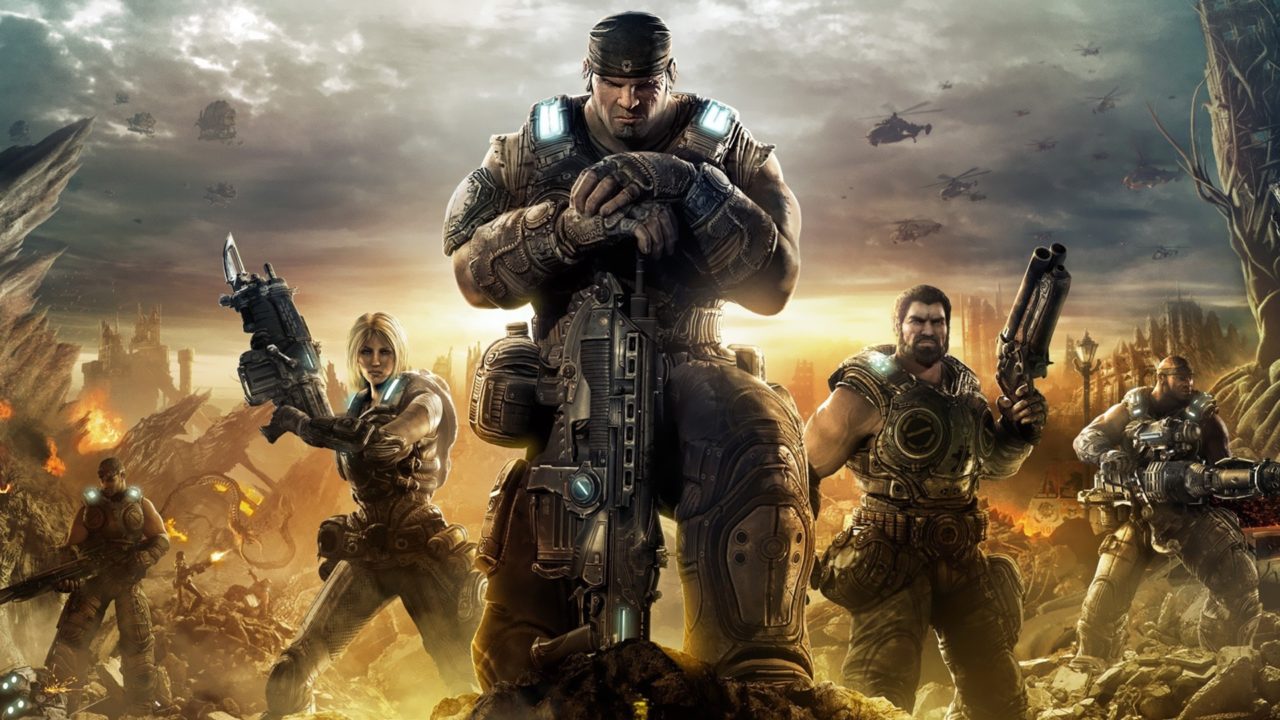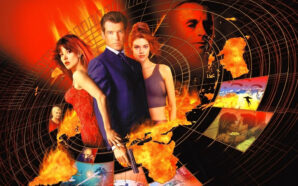I’ve always thought 2011 was an incredible year for gaming. Skyrim, Portal 2, Batman: Arkham City, Uncharted 3, Dead Space 2 and many more. They’re some of my all-time favourites but now I know that 2011 was an even better year than I previously thought. Gears of War 3 was released, ending the original Gears trilogy, and I’ve only just played it eight years later. If you’ve caught my previous two articles in this series, then you’ll know I’ve always been a PlayStation gamer. And while that’s still the case, I’m broadening my horizons and playing some of the Xbox exclusives I’ve missed out on over the last decade or so, starting with the Gears of War franchise. Gears 1 impressed me with its gameplay while Gears 2 invested me in the world and story of the series, so how did 2011’s trilogy-ender shape up compared to the previous instalments?
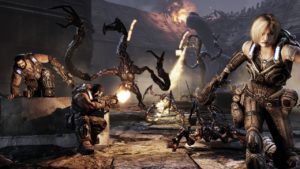 Gears of War 3 picks up two years after the events of the previous game and sees humanity once again struggling to survive. The threat of the Lambent forces – Locust and humans that have been possessed and mutated by the fuel Imulsion – is greater than ever and both the humans and Locust are rapidly facing extinction as their few remaining strongholds are being wiped out. But hope comes from an unexpected source: protagonist Marcus Fenix’s father is alive and has discovered a way to end the Imulsion threat. I greatly appreciate the flashback/dream sequence that begins the game that finally explains why Marcus was imprisoned at the beginning of the trilogy and the backstory of his relationship with his father, although I can’t help wondering that we should have known this from the very start. Gears 3 has a story that’s honestly quite basic but it’s the little moments and character beats that the game nails.
Gears of War 3 picks up two years after the events of the previous game and sees humanity once again struggling to survive. The threat of the Lambent forces – Locust and humans that have been possessed and mutated by the fuel Imulsion – is greater than ever and both the humans and Locust are rapidly facing extinction as their few remaining strongholds are being wiped out. But hope comes from an unexpected source: protagonist Marcus Fenix’s father is alive and has discovered a way to end the Imulsion threat. I greatly appreciate the flashback/dream sequence that begins the game that finally explains why Marcus was imprisoned at the beginning of the trilogy and the backstory of his relationship with his father, although I can’t help wondering that we should have known this from the very start. Gears 3 has a story that’s honestly quite basic but it’s the little moments and character beats that the game nails.
You know a game has started taking its story and characters seriously when it forces you to put your weapons away for a scene and just walk, talk and explore the world. Gears 3 does this multiple times and as much as I didn’t think I cared about these meat-headed soldiers in the previous games, I suddenly felt invested emotionally in some of their journeys. Cole for instance is a character I’ve never cared for or put much thought into and yet the mission where you play as him early on in the game and explore his hometown of Hanover is the best part of the game, maybe even the trilogy. Cole is a local celebrity, recognised from his glory days as a football player for the Cougars, and has to face his past (and lots of Lambent) among the dilapidated streets and stadium he once called home.
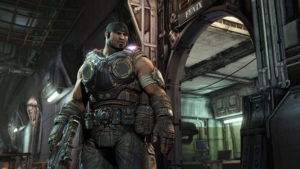 It’s hard not to be disappointed by the overall narrative of the game. It’s basically a road trip Macguffin hunt. You learn what you need and where to find it – Adam Fenix in Azura – early on in the game and it’s not until late in the proceedings – the fifth and final chapter – when you finally get there and accomplish your goal. There are absolutely some fun excursions and missions along the way that offer interesting character beats and lore, but overall the game’s primary narrative is uninspired. While I loved Gears 2, a major failing of it in my opinion was that it had the wrong character for a protagonist. That game was clearly Dom’s story because the emotional pull of the game was Dom’s search for his wife and yet we were granted Marcus as the playable character. Gears 3 has no such issue because we once again play as Marcus, but this time he’s the true driving force of the narrative with the search for his father having both the emotional and narrative stakes.
It’s hard not to be disappointed by the overall narrative of the game. It’s basically a road trip Macguffin hunt. You learn what you need and where to find it – Adam Fenix in Azura – early on in the game and it’s not until late in the proceedings – the fifth and final chapter – when you finally get there and accomplish your goal. There are absolutely some fun excursions and missions along the way that offer interesting character beats and lore, but overall the game’s primary narrative is uninspired. While I loved Gears 2, a major failing of it in my opinion was that it had the wrong character for a protagonist. That game was clearly Dom’s story because the emotional pull of the game was Dom’s search for his wife and yet we were granted Marcus as the playable character. Gears 3 has no such issue because we once again play as Marcus, but this time he’s the true driving force of the narrative with the search for his father having both the emotional and narrative stakes.
Despite the lacklustre plot, Gears of War 3 certainly has much more to say than the previous entries in the series. The other games seemed to show this widespread death and destruction, the epic battles and combat just because it looked cool. They’re fun shallow action games to not think too hard about while you gorily separate limb from torso. But Gears 3 is different. It actually has themes and focuses on the cost of war and human greed, both in plot points but also in the locations and characters you come across in the game’s twisted odyssey. It turns out that the fossil fuel Imulsion, the stuff the inhabitants of the planet Sera have fought and killed over for centuries, is their ultimate enemy and is what creates the Lambent and Locust. This is hardly the most subtle real-world parallel but at least the game is saying something and it’s a welcome addition to the franchise.
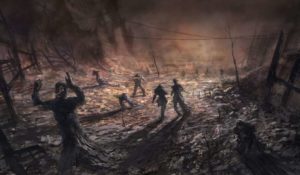 For 3 games now, anyone called anything but Carmine has been indestructible. Marcus and his clan can get out of any fight or ambush completely unscathed to live to fight another day. But Gears 3 makes a point to change that. In fact, the new Carmine character survives and Dom is the one to lose his life, sacrificing himself for the survival of his squad. It’s a good moment, although maybe a little overwrought with the inclusion of ‘Mad World’ on the soundtrack. It’s less the moment itself that works for me but the atmosphere the game creates afterwards. The action moves to the city of Char, a city that embodies death because of it being ground zero for a Hammer of Dawn strike years earlier. Civilians have been turned to dust, and yet still stand, sit or lie in the position they were in at the moment of death, and this creates a morbid labyrinth for Marcus and company to traverse while coming to terms with Dom’s death. These ashen bodies crumble at the slightest touch, so of course I spent the next 20 minutes diving face first through every one of them I could find. But I was certainly sad while doing so. But come on, if you’re living in a city called “Char” you know you probably have a high likelihood of burning alive sometime in the near future, so it’s hard to feel sympathy for all the charred corpses. The new locations of the game on a whole are fantastic and more varied than what was seen in the previous two. I particularly like the contrast of going from Char to the decadent tropical paradise of Azura for the final hours of the game.
For 3 games now, anyone called anything but Carmine has been indestructible. Marcus and his clan can get out of any fight or ambush completely unscathed to live to fight another day. But Gears 3 makes a point to change that. In fact, the new Carmine character survives and Dom is the one to lose his life, sacrificing himself for the survival of his squad. It’s a good moment, although maybe a little overwrought with the inclusion of ‘Mad World’ on the soundtrack. It’s less the moment itself that works for me but the atmosphere the game creates afterwards. The action moves to the city of Char, a city that embodies death because of it being ground zero for a Hammer of Dawn strike years earlier. Civilians have been turned to dust, and yet still stand, sit or lie in the position they were in at the moment of death, and this creates a morbid labyrinth for Marcus and company to traverse while coming to terms with Dom’s death. These ashen bodies crumble at the slightest touch, so of course I spent the next 20 minutes diving face first through every one of them I could find. But I was certainly sad while doing so. But come on, if you’re living in a city called “Char” you know you probably have a high likelihood of burning alive sometime in the near future, so it’s hard to feel sympathy for all the charred corpses. The new locations of the game on a whole are fantastic and more varied than what was seen in the previous two. I particularly like the contrast of going from Char to the decadent tropical paradise of Azura for the final hours of the game.
At the beginning of the first game, Anya appears and shares some meaningful glances with Marcus before giving him some orders. I imagined she was set to be a major character but she does nothing over the course of the first two games except every now and again spout exposition to you over the radio. So it was great to see her properly join the team in Gears 3 and be a companion character for a good portion of the game, spouting exposition as she always does, but also picking up a Lancer (I need to stop calling them “chainsaw guns”) and mowing down just as many hostiles as Cole or Baird. Speaking of Cole and Baird, the pair disappear from the game for far too long and their replacements, Jace and Sam, just don’t cut the mustard. They’re reappearance in the game’s final hour or so was very welcome, but hey, they’re the stars of the entire next game in the series so I can’t complain that much.
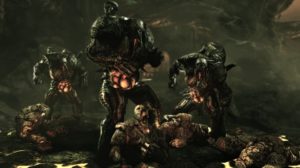 The Lambent are now the primary antagonists of the game and they’re a welcome change from the more standard Locust baddies. Certain concepts carry over like the Lambent emerging from spires that need to be destroyed to stop them from spawning, just like the Locust emergence holes from the other games, but the enemies themselves feel completely new. Well, completely new for Gears because they actually felt a lot like Necromorphs from Dead Space, especially when you have to shoot their mutated limbs off to kill them. They’re such a refreshing enemy that the Locust are quite boring when compared to them, and whenever I was butchering waves of Locust goons, I wished it was the Lambent I was fighting instead. Also, there are zombies now, which once again mixes up the combat to more close-quarters action.
The Lambent are now the primary antagonists of the game and they’re a welcome change from the more standard Locust baddies. Certain concepts carry over like the Lambent emerging from spires that need to be destroyed to stop them from spawning, just like the Locust emergence holes from the other games, but the enemies themselves feel completely new. Well, completely new for Gears because they actually felt a lot like Necromorphs from Dead Space, especially when you have to shoot their mutated limbs off to kill them. They’re such a refreshing enemy that the Locust are quite boring when compared to them, and whenever I was butchering waves of Locust goons, I wished it was the Lambent I was fighting instead. Also, there are zombies now, which once again mixes up the combat to more close-quarters action.
In terms of graphics, I didn’t notice that much of a difference from Gears of War 2 initially. The same grey locations and characters with maybe a little more detail than before. Then one of the new large Lambent enemies exploded and I was nearly blinded by how bright it was. For a 2011 game it looked fantastic and then later on when you traverse more varied locations, I was shocked at how good it looked. There’s a mission called “Breakneck Run” in the middle of the game where you’re on the back of a truck in a convoy darting through a destroyed city and I just wanted to look around and enjoy the scenery. It looked great but I couldn’t take it in because it is a Gears game after all and you can’t go long without shooting at some bad guys.
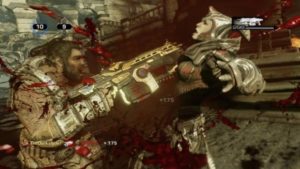 Gameplay-wise there are few changes, but that’s not much of a problem because the gameplay has always been the franchise’s biggest and most consistent strength. It’s still just as satisfying to pump legions of Locust full of lead or cut them in twain with an under-slung chainsaw. The action and combat are great, although I would have liked to have seen another drivable vehicle mission considering that feature debuted in the previous game. The optional paths return and for the first time in the franchise they feel quite drastic in their difference. In the first two games you could decide whether to take the high road or low road, to go left or right, but the two paths were ultimately very similar. In Gears 3 though they can offer completely different experiences and objectives. At one point you can venture from the safety of a fortress to rescue some fellow COG soldiers, being caught up in an ambush if you do so, or you can elect to stay on the fortress walls and provide covering fire. For the first time in the series I wanted to go back and replay chapters, this time picking the alternate route.
Gameplay-wise there are few changes, but that’s not much of a problem because the gameplay has always been the franchise’s biggest and most consistent strength. It’s still just as satisfying to pump legions of Locust full of lead or cut them in twain with an under-slung chainsaw. The action and combat are great, although I would have liked to have seen another drivable vehicle mission considering that feature debuted in the previous game. The optional paths return and for the first time in the franchise they feel quite drastic in their difference. In the first two games you could decide whether to take the high road or low road, to go left or right, but the two paths were ultimately very similar. In Gears 3 though they can offer completely different experiences and objectives. At one point you can venture from the safety of a fortress to rescue some fellow COG soldiers, being caught up in an ambush if you do so, or you can elect to stay on the fortress walls and provide covering fire. For the first time in the series I wanted to go back and replay chapters, this time picking the alternate route.
There is one brand new gameplay mechanic that Gears 3 introduces to the series: a fire extinguisher. Now, fire extinguishers in video-games are pretty boring and I’d much rather get my digital fingers on its antithesis, a flame thrower. But this is a Gears game full of brutal violence and cool unexpected weaponry so there’s got to be something extra with the extinguisher, right? Wrong. You just pick it up, point it at the flames, spray the foam, the flames die down, drop the extinguisher and continue on your journey across the previously burning ground. It’s completely useless and not worth including. I was so convinced I was missing something that I carried the extinguisher with me – which causes you to slow walk because apparently the 260 pounds of pure muscle that make up Marcus Fenix can’t work up the strength to jog while holding it – and tried to spray any Lambent enemies I saw with it, thinking they would freeze or the foam would react with the Imulsion and cause them to explode or something. But no, nothing happens. Then I thought, “oh, this is so basic that its purpose must be to lull me into a false sense of security and of these times I go to use the extinguisher something unexpected will happen”. That it’ll blow up or run out of foam when I’m midway through an inferno, like how every now and then in an Uncharted game a ledge you start to climb collapses to keep you on your toes and make climbing less tedious. But no, again, nothing happens. It turns out just to be a fire extinguisher that works without issue. How boring.
 Jack the useless robot returns in the game’s final chapter, now sporting a very mildly useful stun gun, and characters comment on his previous display of uselessness during the last two games and his newly installed non-lethal weaponry. These comments feel a bit meta so I guess Jack’s inability to do anything apart from open doors when the plot demands them too heavily locked for Marcus to kick through was a complaint at the time, as well as a complaint from me several years later. It’s always interesting to discover what gamers complained about at the time of release and compare them to yours when you’ve just played them for the first time almost a decade later.
Jack the useless robot returns in the game’s final chapter, now sporting a very mildly useful stun gun, and characters comment on his previous display of uselessness during the last two games and his newly installed non-lethal weaponry. These comments feel a bit meta so I guess Jack’s inability to do anything apart from open doors when the plot demands them too heavily locked for Marcus to kick through was a complaint at the time, as well as a complaint from me several years later. It’s always interesting to discover what gamers complained about at the time of release and compare them to yours when you’ve just played them for the first time almost a decade later.
But I’m being a tad facetious, there are some new gameplay additions other than the fire extinguisher and Jack’s taser. No sci-fi franchise would be complete without an Aliens-inspired power loader that can shift heavy crates and, handily, has a machine gun. There are also some fancy new guns to blow yet more heads off, the best being a huge one-shot one-kill rifle that can take down any opponent except for bosses, but to be honest the only gun I ever use is the Lancer, and maybe a shotgun for close encounters. Speaking of bosses, the boss battles in Gears 3 are great. There’s a giant beetle that kills you with light erupting from its mouth which makes no sense but is a fun enemy to encounter and kill using the devastating combo of a chandelier and a laser shot from a satellite. As an arachnophobe, the Corpser Mother boss might be my favourite. You have to eliminate swarms of her freshly-hatched and burrowing spawn before shooting her eyes as she guards them with her creepy multitude of legs.
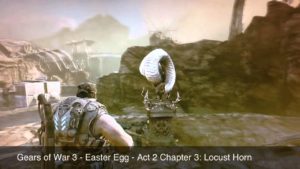 The weirdest addition to the game is the inclusion of stealth sequences but they were anything but in my case. I literally blew the first one by going up to the large Locust horn alarm thing and pressing the prompt to blow in it, alerting the enemies I was supposed to silently put down or sneak around. I gather there were other stealth sections later in the game but I always run in to a new area shooting wildly so I didn’t get a chance to be sneaky. I don’t think that’s my fault; the Gears games condition you to always shoot first and ask questions never, and I wasn’t prepared for stealth. I do in fact like stealth games, just watch me dominate at any of the first three Splinter Cell games and I’ll be as silent and deadly as a particularly nasty fart, but stealth just doesn’t fit with Gears of War and my failure at it is testament enough.
The weirdest addition to the game is the inclusion of stealth sequences but they were anything but in my case. I literally blew the first one by going up to the large Locust horn alarm thing and pressing the prompt to blow in it, alerting the enemies I was supposed to silently put down or sneak around. I gather there were other stealth sections later in the game but I always run in to a new area shooting wildly so I didn’t get a chance to be sneaky. I don’t think that’s my fault; the Gears games condition you to always shoot first and ask questions never, and I wasn’t prepared for stealth. I do in fact like stealth games, just watch me dominate at any of the first three Splinter Cell games and I’ll be as silent and deadly as a particularly nasty fart, but stealth just doesn’t fit with Gears of War and my failure at it is testament enough.
At times it did feel like the game was including action sequences for the sake of action sequences. Of course, that’s always been a thing in these kinds of games – they are action games after all – but Gears 2 was much better at hiding it and weaving in the action set pieces in a more natural fashion. Here the plot is stretched a little too thinly, especially around the middle of the game. Each chapter goes on just a little too long and grazes against becoming boring. The game starts and ends very well, giving you that joy of starting a fun new game and feeling satisfied at the end, but the middle certainly drags.
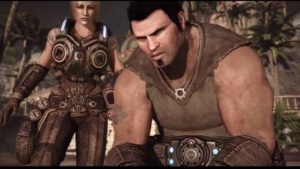 And so, we get to the ending, set on the tropical beaches and ostentatiously lavish hotel of Azura. It’s an unexpected location for this post-apocalyptic tale to conclude but the polarity between story and setting work wonderfully. Marcus and his squad reach his father Adam who has created a device which renders all Imulsion inert, killing the Lambent and Locust. After a tough fight, they make it to the device and activate it but Adam dies in the process. It’s a death that’s trying to be emotional but when you’ve presumed Adam dead for the first two games, if you were even aware of existence at all, it’s hardly a gut punch when he finally kicks the bucket.Marcus kills Queen Myrrah and humanity is saved, although with none of their precious Imulsion left they will have to adapt to survive. The game, and trilogy, ends with Marcus and Anya looking out at the horizon, remembering the past and contemplating the future. Story-wise the ending is fine, if a little generic, but the final few hours are truly fantastic to play and does feel like a culmination of the action and skills you’ve gained over the trilogy. It certainly puts scale before story but, for such an action-orientated series like Gears, I feel that was the right call and I watched the credits roll feeling satisfied.
And so, we get to the ending, set on the tropical beaches and ostentatiously lavish hotel of Azura. It’s an unexpected location for this post-apocalyptic tale to conclude but the polarity between story and setting work wonderfully. Marcus and his squad reach his father Adam who has created a device which renders all Imulsion inert, killing the Lambent and Locust. After a tough fight, they make it to the device and activate it but Adam dies in the process. It’s a death that’s trying to be emotional but when you’ve presumed Adam dead for the first two games, if you were even aware of existence at all, it’s hardly a gut punch when he finally kicks the bucket.Marcus kills Queen Myrrah and humanity is saved, although with none of their precious Imulsion left they will have to adapt to survive. The game, and trilogy, ends with Marcus and Anya looking out at the horizon, remembering the past and contemplating the future. Story-wise the ending is fine, if a little generic, but the final few hours are truly fantastic to play and does feel like a culmination of the action and skills you’ve gained over the trilogy. It certainly puts scale before story but, for such an action-orientated series like Gears, I feel that was the right call and I watched the credits roll feeling satisfied.
Returning to 2011 – the year the game was released – Gears of War 3 managed to recapture the spirit and style of gaming I had back then. I used to play competitive multiplayer, sure, but mostly I concerned myself with playing and replaying the campaigns of my favourite single-player games. While Gears 2 made me a fan of the series, it was Gears 3 that made me want to go back to the beginning and replay the whole trilogy again. To properly follow the story now that I know its endpoint, to pick up on the little details, and to obtain all those collectables and achievements. I rarely replay games nowadays, instead opting to sell the one I’ve ‘completed’ and buy another, but Gears 3 brought me right back to being a young teenager and loving replaying my small collection of games over and over again until I knew every last detail of the landscapes and lore. I still think Gears 2 is the best of the trilogy but I can’t deny the way Gears 3 made me feel. While I’ve still got two games left in the series to play until Gears 5 releases this September, I think I will have to make time to revisit these first three instalments.
In a few weeks’ time, I’ll be tackling Gears of War: Judgement which I’ve heard mixed opinions about but am very much looking forward to playing. In the meantime, what do you think of this article and what’s your favourite Gears game? Let me know in the comments and geek out with me about TV, movies and video-games on Twitter @kylebrrtt.




